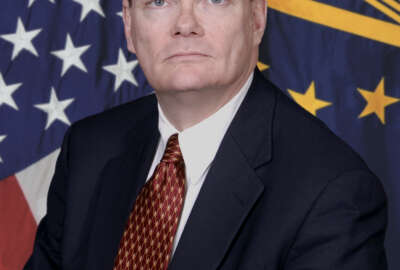
ODNI issues social media guidance for background checks
The Office of the Director of National Intelligence released much-anticipated guidance on using social media during background checks.Bill Evanina, director of the...
Facebook and Twitter are fair game for background checks under new guidance from the Office of the Director of National Intelligence, and the Office of Personnel Management is wasting no time folding it into its pilot program for automated social media site searches.
Under Security Executive Agent Directive 5 agencies may “collect, use and retain” an applicant’s “publicly available social media information” during the background investigation process, as long as it relates to determining whether or not an applicant should have access to classified information or a sensitive position.
Bill Evanina, director of the National Counterintelligence and Security Center at ODNI, said the policy is a collaborative effort to “strike the right balance” between obtaining publicly available information in an ever-changing internet age, without invading privacy or stepping on civil liberties.
“From 2008 until two years ago, the ‘social media’ definition has changed dramatically and will continue to change,” Evanina said. “In order to provide the agencies who conduct these investigations the maximum flexibility to go about utilizing social media as part of this process was paramount in this effort. I’m pretty sure a year from now the social media definition may change, and we wanted to make sure each agency had the flexibility from a resource perspective to identify the best, most efficient way to implement this policy.”
The Office of Personnel Management, which oversees about 95 percent of federal background checks, will use this guidance as it works to stand up by October a pilot program to conduct automated social media site searches as part of the security clearance process.
Acting OPM Director Beth Cobert told Federal News Radio what’s different about this pilot is that it’s focused on the “how.”
“Earlier pilots have proved there’s value. The question is how do we incorporate that into the process in a smart way, in a way that’s smart in terms of resources, in a way that’s smart in terms of being very respectful of privacy; how do we do that right,” Cobert said. “And we’re going to go through this pilot and learn, and I’m guessing we will continue to — as will some other agencies as we do this — learn from our own experiences [and] evolve just as social media keeps evolving.”
Cobert said OPM received more than 30 responses from companies for its April request for information.
“We’re encouraged by the capabilities that are out there,” Cobert said. “We’ll be moving forward in some form. We have a commitment to get the pilot rolling before the end of the fiscal year.”
Cobert said OPM will be looking at how to verify information — that a person is who they say they are on a social media site — as well as what they say on that site is true. Other aspects of the pilot OPM is considering is what information would be gathered that might be collected in other forms to avoid duplicative work, as well as when this information would be collected during the investigation.
“Do you do it at the beginning, so you have leads, or do you do it at the end as a way to verify information you’ve gotten authorized,” Cobert said.
Federal Chief Information Officer Tony Scott said he anticipates the pilot programs under this guidance to show that “some degree of automation” will help with data analysis and in reducing the cost for background investigations, which ranges between $100 and $500.
Getting the whole picture
ODNI’s guidance was met with varying degrees of interest and support from the oversight committee.
Committee Chairman Jason Chaffetz (R-Utah) called the guidance a “big step forward fixing such a glaring lapse in our security clearance process.”
“It defied common sense for the government to overlook social media data available to anyone with an Internet connection,” Chaffetz said.
Rep. Gerry Connolly (D-Va.) said social media was a “promising and valuable source of information,” but was concerned that the government “should not retain social media data of third-parties who happen to engage with the applicant but have not consented to waiving their privacy rights.”
According to the guidance, unless there is a security concern, a requirement to report a crime or the information is relevant for the background check, information collected on someone else other than the applicant will not be kept.
Rep. Ron DeSantis (R- Fl.) asked in light of Standard Form 86, Questionnaire for National Security Positions, which involves an extensive investigation, “what would be the negative just asking ‘hey, do you post online under any type of pseudonym.”
“Why would you want to do [the questionnaire] but then not want to get the whole picture of their online identities,” he added.
Applicants are asked on Form 86 whether they have any other names or aliases.
In the guidance, agencies can’t ask or require an applicant to “take any action that would disclose non-publicly available social media information.”
Evanina said emails and phone conversations aren’t included in background investigations, so getting past the public interface of social media sites gets “to the border of privacy and civil liberties.”
Rep. Mark Meadows (R-N.C.) asked Evanina to return within 60 days after taking a closer look at allowing investigators to ask applicants whether they have other online identities.
“Would those be synonymous with an alias,” Meadows asked.
“They could be sir, they absolutely could be,” Evanina said.
Other SEAD guidance includes instructions that agencies:
- Do not create accounts or use existing social media accounts to connect with an applicant online, or interact with a third party in order to bypass non-public information.
- Verify to the best of their ability any information collected that could disqualify a candidate.
Applicants are not required — nor can agencies ask — to provide passwords or log in to a private account.
More intensive background checks and incorporating social media have been brought to light from recent mass shooting incidents.
Tashfeen Malik, the woman involved in the San Bernardino shooting in December, posted on Facebook praise for the Islamic State group shortly before — or during — an attack she launched with her husband at a federal service center.
A Navy investigation blamed the subcontractor who employed Aaron Alexis, the gunman who killed 12 people at the Washington Navy Yard in 2013, for not telling the government that colleagues had raised concerns about Alexis’ mental state.
Copyright © 2025 Federal News Network. All rights reserved. This website is not intended for users located within the European Economic Area.





